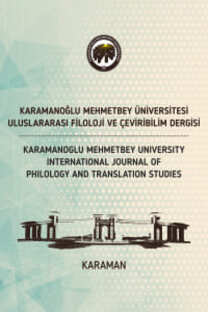"CESARET MADALYASI" VE "SİLAHLARA VEDA" ADLI ROMANLARDA SAVAŞ KAVRAMI
Amerikan İç Savaşı ve kanlı Birinci Dünya Savaşı on milyon insanın ölümüyle, yirmi milyon insanın engelli kalmasıyla ve de özgürlük, demokrasi ve eşitlik gibi değerlerin yok edilmesiyle sonuçlanmıştır. İki savaş, sanat ve fikir dünyasında önemli değişikliklere neden olmuş, kendi edebiyatını oluşturmuş ve bunun sonucunda birçok yazar savaş edebiyatı üretmiştir. Savaş hakkında romanlar yazan modernist yazarlar arasında Stephen Crane ve Ernest Hemingway vardır. Savaşlar, savaş romanı türünde vatanseverlik, milliyetçilik ve kahramanlık kavramlarının hâkim olmasını sağlamıştır. Stephen Crane’in "Cesaret Madalyası" (1895) ve Ernest Hemingway’in "Silahlara Veda" (1929) adlı romanları insan doğası, gerçekçilik ve romantizm açısından incelenmiştir. Crane, genç bir asker Henry Fleming’in psikolojik gelişimini ve savaşın sert atmosferini anlatmıştır. Romanda idealizm-içgüdü, romantizm-gerçekçilik, korkaklık-cesaret gibi tez-antitezler gösterilmiştir. Hemingway, savaştaki şiddetten habersiz olan ve İtalyan ordusunun ambulans birliklerinde gönüllü olarak Teğmen rütbesiyle görev yapan Frederic Henry’nin psikolojik karmaşıklığının haritasını çıkarmıştır. Hemingway, savaşın gerçek aşkı korumayı reddeden bir dünyanın karanlık yüzü olduğunu öne sürmüştür. Crane ve Hemingway, insan doğası, romantizm ve gerçekçilik konularına değinirler. Karakterler, cesaret ve kahramanlık gibi soyut değerler nedeniyle savaşa gönüllü olarak katılmış olsalar da savaşın acı gerçekliğini yaşadıklarında buna katlanamazlar. Bu çalışma, savaşın acımasız ve sert atmosferinin insanoğlu üzerindeki etkilerini göstermiştir.
Anahtar Kelimeler:
Savaş, Modernizm, Gerçekçilik, Romantizm, Stephen Crane, Ernest Hemingway
THE CONCEPT OF WAR IN "THE RED BADGE OF COURAGE" AND "A FAREWELL TO ARMS"
The American Civil War and bloody First World War resulted in the deaths of ten million people, twenty millions disabled people, and destruction of the values such as freedom, democracy and equality. The two wars caused important changes in the world of arts and ideas, created their own literature, and as a result, many writers produced war literature. Among the modernist authors who wrote novels about war are Stephen Crane and Ernest Hemingway, who are the subjects of this study. Wars enabled the concepts of patriotism, nationalism, and heroism to prevail in the war novel genre. Stephen Crane’s "The Red Badge of Courage" (1895) and Ernest Hemingway’s "A Farewell to Arms" (1929) are studied in terms of human nature, realism, and romanticism. Crane describes a young soldier Henry Fleming’s psychological development, and the harsh atmosphere of war. In the novel, thesis-antithesis is shown such as idealism-instinction, romanticism-realism, and cowardice-courage. Hemingway maps the psychological complexity of Frederic Henry who does not know the violence in wars and serves voluntarily in the ambulance corps of the Italian army. Hemingway suggests that war is the dark side of a world that refuses to preserve true love. Crane and Hemingway deal with human nature, romanticism, and realism. Although the characters are volunteers for war due to abstract values of courage and heroism, they cannot bear the harsh reality of war when they experience it. This study demonstrates the effects of the brutal and harsh atmosphere of war on human beings.
Keywords:
War, Modernism, Realism, Romanticism, Stephen Crane, Ernest Hemingway,
___
- Anderson, W. D. (1964). Homer and Stephen Crane. Nineteenth Century Fiction 19(1), 77-86. https://www.jstor.org/stable/2932789
- Avelar, I. (2004). The Letter of Violence Essays on Narrative, Ethics, and Politics. New York: Palgrave Macmillan.
- Beegel, S. (1988). Hemingway’s Neglected Short Fiction. Michigan: UMI Research Press.
- Becker, G. J. (1963). Documents of Modern Literary Realism. New Jersey: Princeton.
- Binder, H. (1978). The Red Badge of Courage Nobody Knows. Studies in the Novel 10(1), 9-47. https://www.jstor.org/stable/29531900
- Bradbury, M. (1983). London 1890‐1920. In M. Bradbury and J. McFarlane (Eds.), Modernism 1890‐1930 (pp. 172-190). London: Penguin.
- Burke, J. (1996). Dismembering the Male: Men's Bodies, Britain and the Great War. Chicago: University of Chicago Press.
- Crane, S. (2011). The Red Badge of Courage. London: Harper Press.
- Dillingham, W. B. (1963). Insensibility in the Red Badge of Courage. College English 25(3), 194-198. https://www.jstor.org/stable/373687
- Edkins, J. (2003). Trauma and the Memory of Politics. Cambridge: Cambridge University Press.
- Ferber, M. (2010). Romanticism: Ave1y Short Introduction. New York: Oxford UP.
- Goodheart, E. (2010). Critical Insights, Ernest Hemingway. Pasadena, CA: Salem Press.
- Gurko, L. (1968). Ernest Hemingway and the Pursuit of Heroism. New York: Thomas Y. Crowell Company.
- Hatten, C. (1993). The Crisis of Masculinity, Reified Desire, and Catherine Barkley in A Farewell to Arms. Journal of the History of Sexuality, 4(1), 76-98. https://www.jstor.org/stable/3704180
- Hemingway, E. (2004). A Farewell to Arms. London: Arrow Books.
- Heyman, N. M. (1997). World War I. London: Greenwood Press.
- Jones, P. G. (1976). War and the Novelist. Columbia: University of Missouri Press, 1976.
- Kübler-Ross, E. and Kessler, D. (2007). On Grief and Grieving: Finding the Meaning of Grief Through the Five Stages of Loss. New York: Scribner.
- Lauter, P. (2014). The Concise Heath Anthology of American Literature 1865 to the Present. Boston: Wadsworth Cengage Learning.
- Lyon, B. (1974). A History of the Western World. Chicago: Rand Mc. Nelly College Publishing.
- Matz, J. (2006). The Novel. In D. Bradshaw and K. J.H. Dettmar (Eds.), A Companion to Modernist Literature and Culture (pp. 215-226). Oxford: Blackwell.
- Miller, W. C. (1970). An Armed America. New York: New York University Press.
- Pratt, L. U. (1939). A Possible Source of the Red Badge of Courage. American Literature 11(1), 1-10. https://www.jstor.org/stable/2920690
- Reynolds, M. S. (1976). Hemingway’s First War: The Making of A Farewell to Arms. New York: Basil Blackwell Press.
- Showalter, E. (1997). Hystorie: Hysterical Epidemics and Modern Culture. New York: Columbia University Press.
- Solomon, E. (1972). Parody and Realism in Stephen Crane’s Fiction. In T. A. Gullason (Ed.), Stephen Crane’s Career: Perspective and Evaluations. New York: New York University Press.
- Spanier, S. W. (1985). Catherine Barkley and the Hemingway Code: Rituel and Survival in A Farewell to Arms. In H. Bloom (Ed.), Modern Critical Views (pp.131-140). New York: Chelsea House Publishers.
- Wallace, J. (2007). Modernists on the Art of Fiction. In M. Shiach (Ed.), The Cambridge Companion to the Modernist Novel (pp. 15-31). Cambridge: Cambridge University Press.
- Yayın Aralığı: Yılda 2 Sayı
- Başlangıç: 2018
- Yayıncı: Karamanoğlu Mehmetbey Üniversitesi
